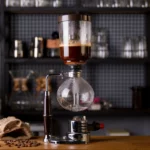Coffee has long been a staple in many cultures around the world, each with their own unique brewing methods and flavor profiles. One such method is Japanese siphon coffee, also known as vacuum pot or syphon coffee. This brewing method dates back to the early 19th century and has since gained popularity for its intricate design and rich, full-bodied taste. In this article, we’ll explore the history of Japanese siphon coffee, how it’s made, and some tips for enjoying it.
History of Japanese Siphon Coffee
The concept of vacuum brewing was first introduced by Loeff of Berlin in the 1830s, and soon after, the siphon brewing method was developed in France. However, it wasn’t until the 1920s when the siphon coffee maker was introduced in Japan and became an integral part of their coffee culture. Today, the siphon brewing method is widely used in Japan, with various adaptations and refinements that have made it a true art form.
How it’s Made
The siphon brewing method involves using two glass chambers, one on top of the other, connected by a tube. The lower chamber is filled with water, which is heated over a heat source until it reaches boiling point. Once boiling, the heat is turned off, and the upper chamber, which contains the coffee grounds, is placed on top of the lower chamber. As the water begins to cool down, it is drawn up through the tube and into the upper chamber, where it infuses with the coffee grounds. After a few minutes of steeping, the heat source is turned back on, causing the water to boil once again and be drawn back down into the lower chamber, leaving behind a rich, flavorful brew in the upper chamber.
Tips for Enjoying Japanese Siphon Coffee
Now that you know how Japanese siphon coffee is made, let’s talk about how to enjoy it. Here are some tips to get the most out of your siphon coffee experience:
- Use high-quality coffee beans: The flavor of your siphon coffee will largely depend on the quality of the coffee beans you use. Look for freshly roasted, high-quality beans for the best flavor.
- Grind the coffee beans correctly: The grind of your coffee beans is also important for achieving the perfect cup of siphon coffee. A medium-fine grind is recommended, similar to the consistency of table salt.
- Experiment with water temperature: The water temperature during the brewing process can affect the taste of your coffee. Some coffee enthusiasts prefer a slightly cooler temperature to bring out the more delicate flavor notes, while others prefer a hotter temperature for a stronger brew.
- Clean your siphon coffee maker: Proper cleaning of your siphon coffee maker is essential for maintaining its longevity and preventing any off-flavors from developing. After each use, disassemble the parts and rinse thoroughly with hot water.
- Enjoy it slowly: Japanese siphon coffee is a delicate and complex brew, meant to be enjoyed slowly and savored. Take the time to appreciate the nuances of the flavors and aromas as you sip your coffee.
Conclusion
Japanese siphon coffee is a unique and flavorful brewing method that has become an integral part of Japan’s coffee culture. With its intricate design and rich, full-bodied taste, it’s no wonder why it has gained popularity among coffee enthusiasts around the world. By following these tips and experimenting with your brewing process, you can create a truly unforgettable cup of siphon coffee.

